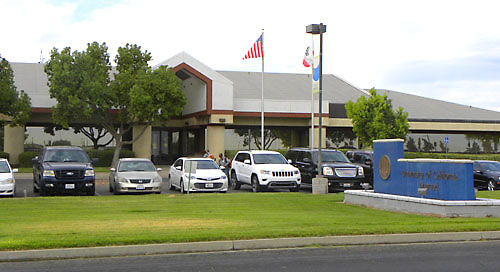California can be a challenging business environment, especially for certain kinds of businesses. Many of the issues that face business in the state somehow intersect with some pretty serious air-quality issues. California’s urban centers have well-documented unhealthy air, but due to a range of issues — some natural and some man-made — parts of the state’s interior also have poor air quality. In reaction, California has sought to improve air emissions, both from mobile sources (cars, trucks, forklifts) and non-mobile sources (factories and power plants).
These are real issues that frankly need attention if the state is to prosper over the long term. The bottom-line question is this: can California continue to flourish while it’s managing its environmental challenges? From our vantage point the answer is a resounding yes, but it will take a more strategic approach to business competitiveness, logistics, infrastructure, and economic development.

California is huge. As a coastal state, if we were to compare it to the U.S. East Coast, California is really the equivalent of six states in terms of population and economic size. In reality, it’s more like a country than a state, as it represents the sixth-largest economy in the world, according to the IMF. Because of European growth issues and Brexit, California could move into the #5 slot in the next few years, passing the UK. California has a Gross State Product of $2.5 trillion, which is 4.1 percent higher in 2016, and 71 percent higher than the national growth rate (2.4 percent). Clearly, California is not withering away as some might be saying.
The state is a huge production market, a foundation being agribusiness, which is a $50 billion annual business (California being the largest agricultural producer and exporter in the U.S.). Technology manufacturing is strong and includes global supply chain centers for aerospace, health/life science products, software, chemicals, industrial machinery, and now automotive. With more than 1.1 million employed in manufacturing, California supports more manufacturing jobs by far than any other state.
In reality, it’s more like a country than a state, as it represents the sixth-largest economy in the world. According to the IMF As a consumption market, California is an intoxicating place for selling things; it has a lot of people, a consumer base with overall high incomes, and a quite diverse population. Much of that consumption base is conveniently concentrated in the global mega-market regions of the Bay Area and Los Angeles.
There is also a range of important global-scale logistics assets that are fundamental to the state’s economic base and potential, representing a large advantage over other domestic regions. California fares well for air and ocean connectivity, which is a defining factor of a trading economy. With its west-facing coastline, the state is home to a number of very strategic seaport logistics assets, including the ports of Los Angeles, Long Beach, and Oakland. The global airports of SFO and LAX each provide passenger and cargo connectivity to markets in Asia and Europe.
Large consumption and production markets and seamless global connectivity are an economic development cocktail that most places can only aspire to have.
The Ignored California: An Important Key to the State’s Future
The interior of the state has essentially been discounted by policy, public investment, and private risk capital. After all, with the tech capital of the world in Silicon Valley and the diversified economic monster of the Los Angeles basin, the Central Valley hasn’t received a lot of attention. It’s viewed as poorer and less educated, and its elected leadership has been somewhat more conservative — this hasn’t helped in drawing the attention of state government.
California’s Central Valley is a paradox, best known as the richest agricultural region in the U.S. and one of the most important food product producers in the world. That California is hugely productive but otherwise taken for granted. Its population of 6.5 million is spread throughout the Valley, so it’s a major market all by itself.
As compared to the state’s urban centers, the Valley is far less expensive (land and labor) and is very well located from a transport/supply-chain perspective. It is extremely close to Bay Area and Los Angeles markets, and depending on Valley location, it’s a one- to five-hour drive to ports, airports, and consumption markets in San Francisco or Los Angeles. This means that through-shipped goods on the way to Asia, for example, can be transported from the production site to an ocean carrier or airplane that afternoon. This is a substantial competitive advantage over most domestic competitor locations, which are generally between one and three days’ drive to key logistics centers.
Castle Redevelopment Project
A former USAF Strategic Air Command Base, Castle Airport is a 2,000-acre intermodal campus with an active airport and a collection of high-tech and manufacturing businesses.
-
USAF Strategic Air Command Base
Located in California’s Central Valley is Castle, a former USAF Strategic Air Command Base, which was built in the early 1940s and was home to more than 6,000 personnel until its closing in 1996.
-
Castle Airport
Castle Airport is a 2,000-acre intermodal campus — an active airport with an 11,800-foot runway, a flight school that trains commercial pilots from all over the world, and a collection of high-tech and manufacturing businesses.
Google
Google has built its off-road autonomous-car testing facility here.
U.S. Forest Service
The U.S. Forest Service bases aircraft there to fight forest fires in the western United States, and both Air Force One and Two have landed there when the President or First Lady has attended an event in the Valley.
-
Mackey & Sons
Kansas-based Mackey & Sons has established a West Coast manufacturing plant for heavy cranes for export to Asia due to the proximity to the Port of Oakland.
-
Atwater-Merced Expressway
The site will also have two interchange access points to the new Atwater-Merced Expressway.
Located in California’s Central Valley is Castle, a former USAF Strategic Air Command Base, which was built in the early 1940s and was home to more than 6,000 personnel until its closing in 1996. A BRAC project, the Castle closure was a tremendous blow to Merced County, home to more than 250,000 people, as the base had been an anchor for many years.
Today, Castle Airport is a 2,000-acre intermodal campus — an active airport with an 11,800-foot runway, a flight school that trains commercial pilots from all over the world, and a collection of high-tech and manufacturing businesses. For example, Google has built its off-road autonomous-car testing facility there, and Kansas-based Mackey & Sons has established a West Coast manufacturing plant for heavy cranes for export to Asia due to the proximity to the Port of Oakland. Additionally, as an operating airport, Castle serves an important niche role for a variety of users including the federal government. The U.S. Forest Service bases aircraft there to fight forest fires in the western United States, and both Air Force One and Two have landed there when the President or First Lady has attended an event in the Valley.
Building on that platform, Castle is being transformed to become a strategic California location for a range of manufacturing and regional distribution investment, particularly tech-oriented activities specifically related to supply chains that have a large presence in the state, such as industrial machinery, aerospace/space, automotive, specialty chemicals, and food production. Situated in almost the exact geographic center of the state, the project is 80 miles directly east of San Jose and a few hours’ dray to the ports of Los Angeles and Long Beach. As a purpose-designed, multimodal trade district, the Castle transformation represents a very important asset for projects that are probably otherwise not going to consider California as an investment option.

The site is master-planned to accommodate five to seven million square feet of development, including a range of uses and building sizes, including sites that can support up to 1.5-milion-square-foot investments. Some sites will have access to the airfield, and others will have direct access to the BNSF mainline. The site will also have two interchange access points to the new Atwater-Merced Expressway. The development will make extensive use of on-site infrastructure that’s already in place, representing a clear advantage. Plans also include a hotel, a retail complex, and some small office sites. In total, this development represents a $1 billion investment of private capital, a scale that is unprecedented in the Central Valley.
Merced County has developed a visionary delivery plan that will move forward as a large-scale public-private partnership. The project will include one or several private investors that believe in the Central Valley market proposition. As an interested development partner, Merced County is actively undertaking an action strategy that includes:
- Rezoning the entire property to a flexible commercial zoning classification
- Working with the federal government to maximize development around an active airport
- Working with local, state, and federal agencies to move the Atwater-Merced Expressway forward (next phase to the site)
